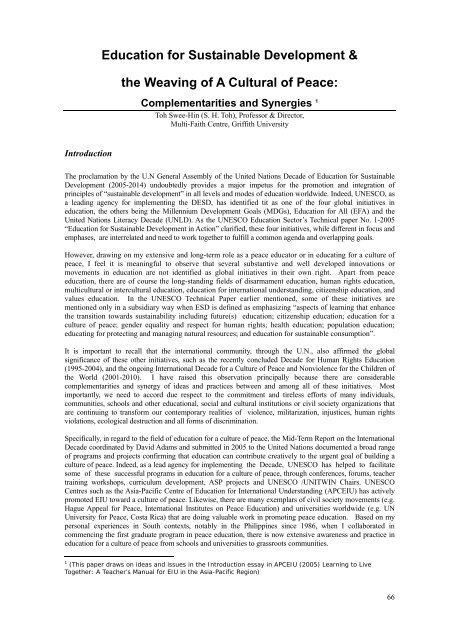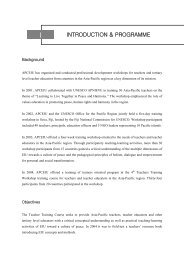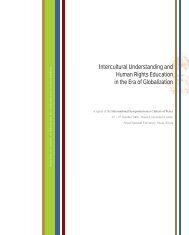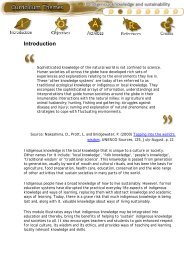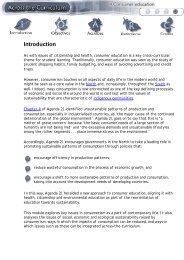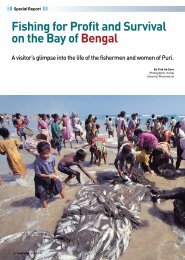REPORT OF UNESCO EXPERT MEETING ON - APCEIU
REPORT OF UNESCO EXPERT MEETING ON - APCEIU
REPORT OF UNESCO EXPERT MEETING ON - APCEIU
You also want an ePaper? Increase the reach of your titles
YUMPU automatically turns print PDFs into web optimized ePapers that Google loves.
Education for Sustainable Development &<br />
the Weaving of A Cultural of Peace:<br />
Complementarities and Synergies 1<br />
Toh Swee-Hin (S. H. Toh), Professor & Director,<br />
Multi-Faith Centre, Griffith University<br />
Introduction<br />
The proclamation by the U.N General Assembly of the United Nations Decade of Education for Sustainable<br />
Development (2005-2014) undoubtedly provides a major impetus for the promotion and integration of<br />
principles of “sustainable development” in all levels and modes of education worldwide. Indeed, <strong>UNESCO</strong>, as<br />
a leading agency for implementing the DESD, has identified tit as one of the four global initiatives in<br />
education, the others being the Millennium Development Goals (MDGs), Education for All (EFA) and the<br />
United Nations Literacy Decade (UNLD). As the <strong>UNESCO</strong> Education Sector’s Technical paper No. 1-2005<br />
“Education for Sustainable Development in Action” clarified, these four initiatives, while different in focus and<br />
emphases, are interrelated and need to work together to fulfill a common agenda and overlapping goals.<br />
However, drawing on my extensive and long-term role as a peace educator or in educating for a culture of<br />
peace, I feel it is meaningful to observe that several substantive and well developed innovations or<br />
movements in education are not identified as global initiatives in their own right. Apart from peace<br />
education, there are of course the long-standing fields of disarmament education, human rights education,<br />
multicultural or intercultural education, education for international understanding, citizenship education, and<br />
values education. In the <strong>UNESCO</strong> Technical Paper earlier mentioned, some of these initiatives are<br />
mentioned only in a subsidiary way when ESD is defined as emphasizing “aspects of learning that enhance<br />
the transition towards sustainability including future(s) education; citizenship education; education for a<br />
culture of peace; gender equality and respect for human rights; health education; population education;<br />
educating for protecting and managing natural resources; and education for sustainable consumption”.<br />
It is important to recall that the international community, through the U.N., also affirmed the global<br />
significance of these other initiatives, such as the recently concluded Decade for Human Rights Education<br />
(1995-2004), and the ongoing International Decade for a Culture of Peace and Nonviolence for the Children of<br />
the World (2001-2010). I have raised this observation principally because there are considerable<br />
complementarities and synergy of ideas and practices between and among all of these initiatives. Most<br />
importantly, we need to accord due respect to the commitment and tireless efforts of many individuals,<br />
communities, schools and other educational, social and cultural institutions or civil society organizations that<br />
are continuing to transform our contemporary realities of violence, militarization, injustices, human rights<br />
violations, ecological destruction and all forms of discrimination.<br />
Specifically, in regard to the field of education for a culture of peace, the Mid-Term Report on the International<br />
Decade coordinated by David Adams and submitted in 2005 to the United Nations documented a broad range<br />
of programs and projects confirming that education can contribute creatively to the urgent goal of building a<br />
culture of peace. Indeed, as a lead agency for implementing the Decade, <strong>UNESCO</strong> has helped to facilitate<br />
some of these successful programs in education for a culture of peace, through conferences, forums, teacher<br />
training workshops, curriculum development, ASP projects and <strong>UNESCO</strong> /UNITWIN Chairs. <strong>UNESCO</strong><br />
Centres such as the Asia-Pacific Centre of Education for International Understanding (<strong>APCEIU</strong>) has actively<br />
promoted EIU toward a culture of peace. Likewise, there are many exemplars of civil society movements (e.g.<br />
Hague Appeal for Peace, International Institutes on Peace Education) and universities worldwide (e.g. UN<br />
University for Peace, Costa Rica) that are doing valuable work in promoting peace education. Based on my<br />
personal experiences in South contexts, notably in the Philippines since 1986, when I collaborated in<br />
commencing the first graduate program in peace education, there is now extensive awareness and practice in<br />
education for a culture of peace from schools and universities to grassroots communities.<br />
1 (This paper draws on ideas and issues in the Introduction essay in <strong>APCEIU</strong> (2005) Learning to Live<br />
Together: A Teacher’s Manual for EIU in the Asia-Pacific Region)<br />
66


